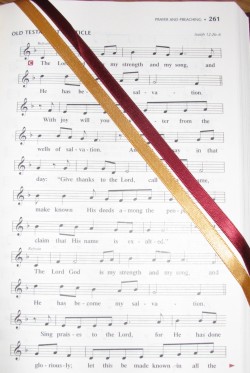(One of the goals of Brothers of John the Steadfast is to train the Brothers in good practice and theology. This article is one in a series that teaches about the liturgy.
These articles were initially intended to be put into bulletins or read during the service to educate the laity on the different parts of the service. They were therefore purposefully made short. Thanks to Pr. Mathey for helping to enhance this reading. Please use the comment section or email us to help us expand the series as appropriate.)
Notes on the Liturgy #5 – Introit, Psalm or Hymn
 This canticle was written by BJS steering committee member Phil Magness
This canticle was written by BJS steering committee member Phil Magness
Having received Absolution the congregation moves from the time of preparation to that part of the worship known as “the service of the Word.” We begin the service of the Word with an Introit, Psalm, or Hymn.
Let’s get into the history of this practice by focusing on that word “introit.” It means “entrance” or “beginning”. As Christians moved from a persecuted minority to the official majority they also moved from having worship in someone’s home to larger basilicas. This in turn afforded the opportunity to adorn the service with liturgical details that would not have been possible in a cramped home church.
“In the early fifth century, Pope Celestine I (died 432) decreed that an entire psalm should be sung antiphonally (back and forth) by a double choir as the clergy came from the sacristy (at the back of the church) to the altar. This was intended to add solemnity to the entrance of the clergy and to establish the thought or mood appropriate for the particular service.” (L. Reed in The Lutheran Liturgy) Essentially the Introit was travel music.
Today the Introit is a little different. As stated above, it comes after the Absolution to begin the service of the Word rather than beginning the entire worship service as it did in Celestine’s time. The introit is part of the propers of the day. That means it changes from Sunday to Sunday. In “Lutheran Worship,” the propers for the day start on page 10. Turn to it. Take note of the introit and the other propers before you read on. (the propers are no longer in the LSB hymnal, so we’ll use LW for this example)
The introit is not a whole psalm but a part of a psalm that contains the insertion of a repeated verse called an “antiphon”. The antiphon will help set the theme for the day. See how in “Lutheran Worship” the antiphon begins and ends the Introit. Turn to each page listed below and see how the antiphon helps set the theme for the day:
Page 10, for the first Sunday in Advent the Introit begins with the antiphon that says, “See your King comes to you…” Page 20, for Epiphany the Introit begins with the antiphon that says, “All kings will bow down to him…” Page 43, for Maundy Thursday, when Christ gave Communion, The antiphon says, “I will lift up the cup of salvation…” Page 47, for Easter the Introit begins with an antiphon that says, “Alleluia, Christ has risen…”
An Introit, Psalm or Hymn is appropriate after the absolution. Having been forgiven, it is natural to sing to the Lord as we come into His presence with Thanksgiving. The pastor may show this in a visual way by literally “entering” into the chancel during this part of the Liturgy. Prior to this point of the service, he would have been outside of the communion rails as a part of the congregation. Now, he may enter into the chancel which is the Christian version of the Holy of Holies. A Psalm or Introit is often used because the book of Psalms has been the prayer and hymn book of the church since Old Testament times, and it is a way in which the saints of all ages are joined together in worshipping the one true God. The Gloria Patri, or Glory be to the Father, ends the Introit or Psalm to proclaim beyond a shadow of a doubt to anyone present that we are addressing the Triune God in His own words that may be chanted to show how special they are.
Notes on the Liturgy —
Introduction
Invocation
Confession
Absolution
Introit, Psalm or Hymn
You may find all these by looking at the Explanation of the Divine Service category or by https://steadfastlutherans.org/liturgy.
These notes were originally written in 2001 by Pastor David Oberdieck and have been edited. Thanks for Pr. Mathey for helping to enhance this article.